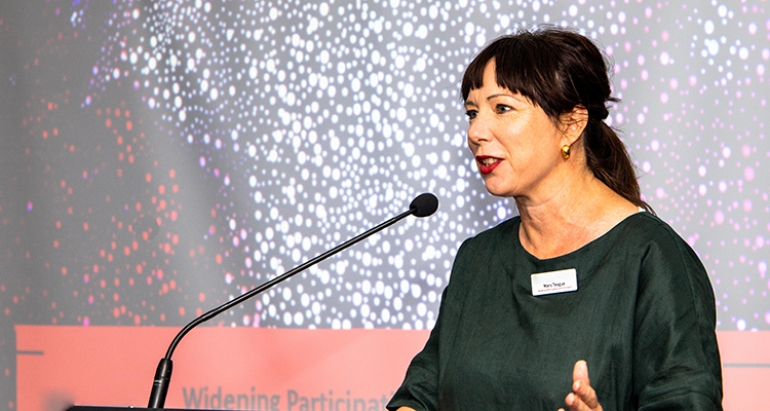The new Director of AimHigh shares why student equity and outreach programs offered in secondary schools are important in shaping the lives of young people.
The AimHigh unit at UNSW supports pre-entry programs and initiatives to university. The overall objective is to increase access to university of students who come from diverse backgrounds who are underrepresented in higher education institutes. AimHigh’s new Director, Mary Teague shares what drives her in pursuing social justice for students, regardless of circumstance when looking toward future education opportunities.
Can you tell us about your previous role as the Head of Widening Participation and Outreach at the University of Sydney?
My previous role had a similar focus, where I was responsible for widening access for students from low-SES backgrounds. We also led a large strategic pre-tertiary outreach program for the DVC-Indigenous Strategy and Services. We were very focused on recalibrating the admissions pathways and undertook a large advocacy and governance piece internally. There are some exciting challenges at UNSW in developing the admissions pathway. I’m looking forward to leading this under the Division of Equity Diversity and Inclusion and with the faculties, and areas such as Admissions, Future Students, and Student Experience and Support.
What motivates you to work in the area of student equity programs in the higher education sector?
A combination of things drew me to this work. In my early career as a secondary school teacher, and sessional academic here at UNSW, I was overwhelmed by the barriers faced by many students and their resilience and perseverance in pursuing their education. I am motivated to improve that experience of education because it is still the key factor in social mobility.
What are some of the barriers that prevent students from low socio-economic backgrounds to access a University education?
The barriers are vastly different, say between schools across south western Sydney and different again compared to regional or remote areas in NSW. However, one of the significant barriers that is common across the board is our institutional reliance on ATAR and how school-based disadvantage intersects with students’ individual ATAR attainment. One challenge is to advocate for an institutional position that can implement structural reforms and contribute in a constructive way to equity debates around school funding in NSW, and that we utilise institutional influence to impact some structural reforms.
Can you share a memorable story or experience that highlights how outreach programs in schools have the potential to change young peoples’ lives?
I was working on a short series of videos, an inclusive teaching and learning resource for academics, where students commonly spoke about the assumptions that occurred in exchanges in class. One story is still top of mind for me. A tutor said to one student, “You’re quick, you must have gone to Sydney Boys High School.” The student was of Chinese background and went to a school in outer western Sydney. Although the comment was intended as a compliment, it made him feel deeply uncomfortable and confronted by racial stereotyping. When he said where he went to school another student said, “Is that even in Sydney?” It kept compounding a sense of exclusion.
This story reminds me to place students and their learning experience at the centre of what we do when designing programs that are intended to support or enable.
What effect do outreach programs, such as ASPIRE, have on the broader school community including teachers, school principals and the families of children whose schools participate in the program?
In my experience, when a student is the first in their family to graduate with a degree, the impact is hugely positive. However, it can be difficult when there is a lack of success stories to share back with school communities and continue the momentum of success to impact young students. HEPPP funded outreach programs have operated in schools for 10 years, yet there is still a lot of work to do to increase access for students from low SES backgrounds across the Go8 universities. I want UNSW to be a leader in this and to be part of that change.
